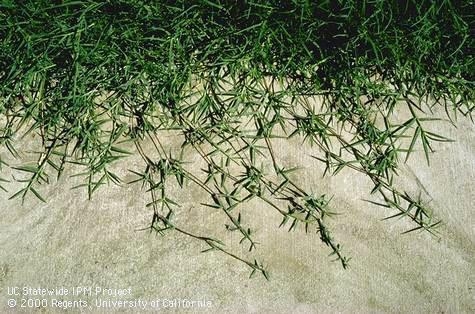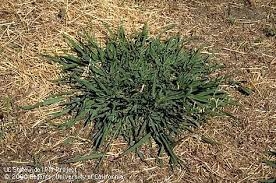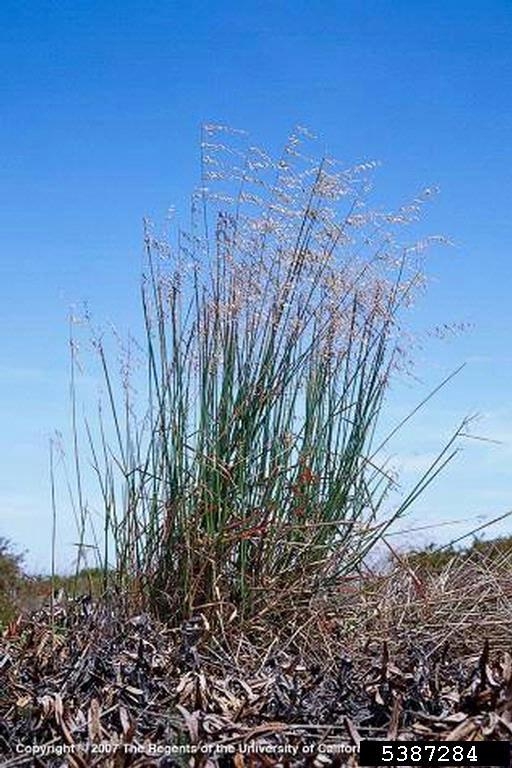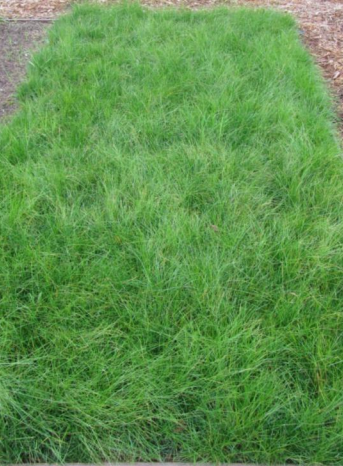
all pix UC
1) rototill what's left of the current lawn and remove as many grass clods and rhizomes as I can gather up in this process
3) cover with newspaper
4) cover that with more soil (excavated from a large bed elsewhere in the yard; clean and much better structure) and compost
5) poke holes into the paper to plant some F. rubra plugs I bought (prematurely) and overseed with F. rubra seed.
6) cover with mulch.
Client's Reasoning
- the soil is so compacted that it NEEDS some cultivation, despite the risk of chopping up rhizomes (besides existing grass is not very healthy); I'm loathe to put off cultivation till spring because if we get El Nino type rain that could just exacerbate the clay soil structure (ie, further compaction)
- I can plant the grass plugs now through the newspaper
- F. rubra seed can take advantage of early rains now and newspaper will hopefully rot by spring so new grass seedlings can tap the underlying soil then when days lengthen, temps rise and growth rate increases
- If El Niño rains come, this approach will prevent excessive pooling and muddy bog conditions.
The other option is rototilling and sheet mulching now and composting and seeding in March or so.
I'd appreciate your thoughts and comments. Thanks very much for your time.
Help Desk Response: Thank you for contacting the Master Gardener Help Desk concerning your lawn conversion from Bermudagrass to red fescue.
Bermudagrass can be pretty tough to eliminate. The best methods include the following (summarized from very detailed University of California information located at http://www.ipm.ucdavis.edu/PMG/PESTNOTES/pn7453.html):
1. Herbicide such as Roundup™, during spring and summer. Herbicide will only be effective if applied when the Bermudagrass is growing vigorously, meaning it should be applied during spring and summer. Stolons may not be completely killed by herbicide, so cultivation may also be required, as further described below.
2. Withholding water during summer. This tactic is usually combined with cultivation, also further described below.
3. Shading. Sheet mulch with overlapping cardboard sheets, covering the cardboard with at least 3 inches of mulch. Mulch alone will not be effective. More information on sheet mulching, including a "how to" slide show, can be found here http://www.bayfriendlycoalition.org/LYL.shtml 
Based on the above, you can see that summer is the best time to effectively eradicate Bermudagrass by using a combination of methods. Herbicides will not be effective during late fall and winter because the Bermudagrass will not be growing vigorously. If you decide to cultivate and hand remove rhizomes and stolons, followed by sheet mulching, that is probably your best bet this time of year. However, we would recommend that you wait to plant the fescue plugs until you are confident the bermudagrass has been killed. If you do not, there is the potential that the bermudagrass will grow through the planting holes.
It is true that fall is the best time to seed Festuca rubra to take advantage of the rains. Festuca rubra is a low water use plant according to WUCOLS http://ucanr.edu/sites/WUCOLS/Plant_Search/. However, even plants that are classified as "low water use" require supplemental water for the first year or two to get their root systems established and are drought tolerant only thereafter. You may want to keep this in mind when deciding when, and how much, to plant, in case landscape watering restrictions continue next year.
General advice from the University of California about establishing and maintaining lawns can be found here, including information on pre-plant fertilizer http://www.ipm.ucdavis.edu/TOOLS/TURF/ We do also recommend that you have your soil tested to determine if certain nutrients are lacking so that you can fertilize and amend appropriately. A list of soil testing laboratories can be found at http://ccmg.ucanr.edu/files/51308.pdf. The soil testing labs' websites have instructions on how to collect samples and submit them for analysis, but you should contact the lab first to get their specific requirements for you situation. A basic soil test should include the major nutrients of nitrogen, phosphorus and potassium (N, P, K) as well as pH and organic matter. pH will tell you whether your soil is neutral, acidic or alkaline - this is important because pH can impact nutrient availability. Ideally you will want the soil pH to be between 5.5 to 7.5. 5% organic matter is considered ideal; our clay soils usually have much lower than ideal levels, but can usually be improved with the addition of compost.
Good luck with your ambitious project. I hope that this information is helpful. Please do not hesitate to contact us again if you have any further questions.
***************************************************
Editor's Addendum: A relatively new development on the California turf scene is that at least one sod grower, and probably others as well, are now providing ready-to-install sod that consists primarily of native grasses and also touting significant reduction in water use. Your circumstances might warrant consideration of such sod. Details on feasibility and costs should be available at most retail nurseries or online.
***************************************************
Help Desk of the UC Master Gardeners of Contra Costa County (JL)
Note: The UC Master Gardeners of Contra Costa's Help Desk is available year-round to answer your gardening questions. Except for a few holidays, we're open every week, Monday through Thursday for walk-ins from 9:00 am to Noon at 75 Santa Barbara Road, 2d Floor, Pleasant Hill, CA 94523. We can also be reached via telephone: (925) 646-6586, email: ccmg@ucanr.edu, or on the web at http://ccmg.ucanr.edu/Ask_Us/ MGCC Blogs can be found at http://ccmg.ucanr.edu/HortCoCo/ You can also subscribe to the Blog (//ucanr.edu/blogs/blogcore/blogroll.cfm).